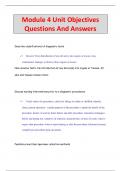Module 4 Unit Objectives
Questions And Answers
Describe classifications of diagnostic tests
✓~ Invasive Tests-Introduction of any device(s) into organs or tissues; may
contaminate, damage, or destroy those organs or tissues.
Non-invasive tests- No introduction of any device(s) into organs or tissues. All
skin and tissues remain intact.
Discuss nursing interventions prior to a diagnostic procedures
✓~ Verify orders for procedures, check for allergy to iodine or shellfish, identify
client, patient education - explain purpose of the procedure, explain the details of the
procedure, dietary of activity limits before and after procedure, relaxation techniques
before and during test, sedatives (if ordered), characteristics of dyes (if used), what to
expect after procedure, what to report during or after the procedure. Informed consent,
complete pre-procedure prep, document.
Possible urine/stool specimen collection methods
, ✓~ Random, Timed, Collection from a closed drainage system, clean-voided
specimen (not sterile), from any source except toilet digital extraction is permissible.
Define pain
✓~ n unpleasant sensory and emotional expience related to tissue injury.
Describe pain assessment components
✓~ Pain Pattern
Breakthrough Pain
Location of Pain
Intensity of Pain
Quality/Description of Pain
What makes it better?
What makes it worse?
How long has it been happening? When did it start?
Constant or comes and goes?
Discuss barriers to adequate pain relief for clients.
, ✓~ -Tolerance, Dependence, Addiction, HCP's attitude, System Barriers, Fears,
Cultural attitudes
Non-pharmacological pain interventions
✓~ Acupuncture, Biofeedback, Massage, Heat/Cold,
Meditation, Relaxation, Distraction, Art/music therapy,
Imagery, Chiropractic, Hypnosis, Therapeutic touch
Compare/contrast sensory and cognitive alterations
✓~ Sensory- impaired receptive ability (think 5 senses)
Cognitive- impaired ability to process info provided by the senses
Use the Nursing Process to identify and treat patients with sensory alterations
✓~ Identify: Ask A&O (x1-4) questions, Ask questions about vision, taste, smell,
touch, etc. Identify abnormals. Pay attention to pt's reaction to surroundig
environment. Is pt at risk for sensory overload or deprivation?
Treatment: Use common sense. What are some easy ways to stimulate the sense
that needs help? (Think about the group exercise in class.) Would assistive




